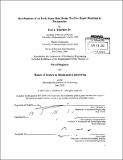| dc.contributor.advisor | Chryssostomos Chryssostomidis. | en_US |
| dc.contributor.author | Thurkins, Eric J., Jr | en_US |
| dc.contributor.other | Massachusetts Institute of Technology. Dept. of Mechanical Engineering. | en_US |
| dc.date.accessioned | 2012-11-19T19:33:11Z | |
| dc.date.available | 2012-11-19T19:33:11Z | |
| dc.date.copyright | 2012 | en_US |
| dc.date.issued | 2012 | en_US |
| dc.identifier.uri | http://hdl.handle.net/1721.1/74992 | |
| dc.description | Thesis (Nav. E. and S.M.)--Massachusetts Institute of Technology, Dept. of Mechanical Engineering, 2012. | en_US |
| dc.description | Cataloged from PDF version of thesis. | en_US |
| dc.description | Includes bibliographical references (p. 85). | en_US |
| dc.description.abstract | In early-stage ship design, it is helpful to perform preliminary design and analysis on many configurations to assist in developing and narrowing the trade space. This process is further complicated with the increasing interest in concepts that are breaks from previous practice, such as Integrated Power System (IPS) designs, which require initial development to go deeper than historically based parametrics can provide. Paramarine is a ship design and analysis tool which can be used in this early-stage design; however, as with many early-stage design tools, the fleshing out of diverse ideas in Paramarine can be time and resource consuming. In an effort to enable a developer to create early-stage designs with depth significant enough to be meaningful but still general enough to allow the level of flexibility in design required in the early stages of development, this project seeks to develop an Early Stage Ship Design Tool (ESSDT). This ESSDT is a novel interface with which a designer can rapidly develop and alter basic, major design components of a ship from a compiled database of components and gain a rendered model for analysis within the naval design tool Paramarine. By making use of many early-stage parametric and developed calculations and leveraging the use of IPS, this ESSDT automates many of the initial ship's estimates and minutia of design. Utilizing both Excel and Paramarine software, the ESSDT rapidly creates a visual model of a basic naval vessel with primary systems and equipment from relatively few initial user inputs while embodying a depth of user-changeable default settings for more complex and non-standard design efforts. Several case studies were run to show the capability and flexibility of the tool, as well as showing how new powering and mechnical systems can affect the parameters of the ship as a system of systems. | en_US |
| dc.description.statementofresponsibility | by Eric J. Thurkins Jr. | en_US |
| dc.format.extent | 248 p. | en_US |
| dc.language.iso | eng | en_US |
| dc.publisher | Massachusetts Institute of Technology | en_US |
| dc.rights | M.I.T. theses are protected by
copyright. They may be viewed from this source for any purpose, but
reproduction or distribution in any format is prohibited without written
permission. See provided URL for inquiries about permission. | en_US |
| dc.rights.uri | http://dspace.mit.edu/handle/1721.1/7582 | en_US |
| dc.subject | Mechanical Engineering. | en_US |
| dc.title | Development of an early stage ship design tool for rapid modeling in Paramarine | en_US |
| dc.type | Thesis | en_US |
| dc.description.degree | Nav.E.and S.M. | en_US |
| dc.contributor.department | Massachusetts Institute of Technology. Department of Mechanical Engineering | |
| dc.identifier.oclc | 814533998 | en_US |
